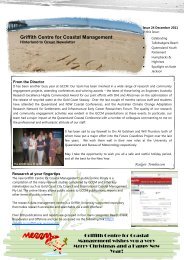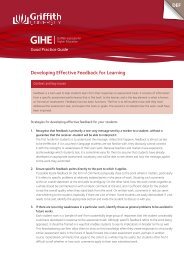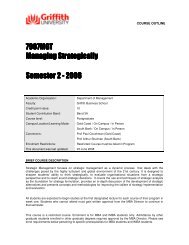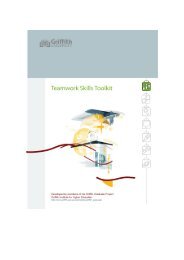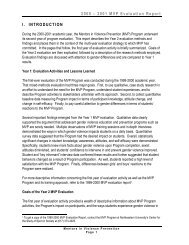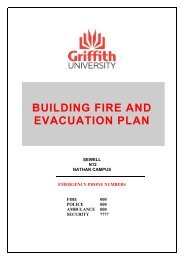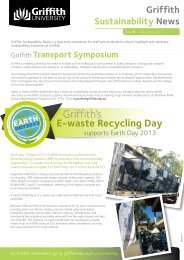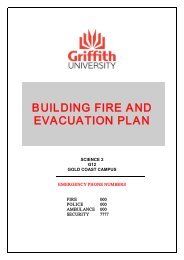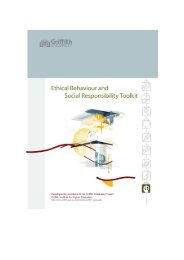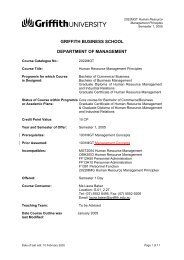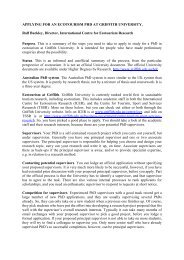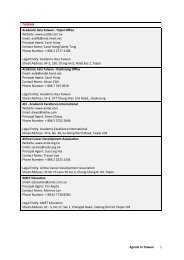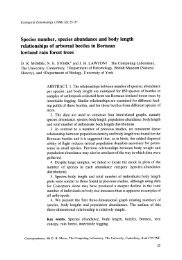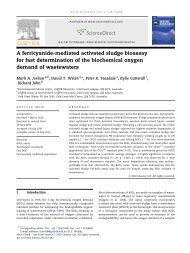Urban Greenspace: Connecting People and Nature - Griffith University
Urban Greenspace: Connecting People and Nature - Griffith University
Urban Greenspace: Connecting People and Nature - Griffith University
You also want an ePaper? Increase the reach of your titles
YUMPU automatically turns print PDFs into web optimized ePapers that Google loves.
Environment 13<br />
<strong>Urban</strong> <strong>Greenspace</strong>: <strong>Connecting</strong><br />
<strong>People</strong> <strong>and</strong> <strong>Nature</strong><br />
Guy Barnett<br />
Michael Doherty<br />
Matthew Beaty<br />
CSIRO Sustainable Ecosystems, Canberra<br />
Email: guy.barnett@csiro.au<br />
michael.doherty@csiro.au<br />
matt.beaty@csiro.au<br />
ABSTRACT<br />
The influence of enlightened greenspace planning can be seen in some but not all of Australia’s<br />
cities – notably Adelaide, Melbourne <strong>and</strong> Canberra. There have been recent suggestions that many<br />
contemporary planners <strong>and</strong> developers have deserted the “garden city” concept in favour of private<br />
greenspace. However, there is a considerable level of uncertainty about the impacts associated with<br />
the deterioration <strong>and</strong> loss of urban greenspace <strong>and</strong> the biodiversity these areas contain, particularly<br />
in relation to the sustainability <strong>and</strong> quality of urban life. In this paper we revisit the connection<br />
between people <strong>and</strong> nature in the city, through a focus on identifying spatial patterns of urban<br />
greenspace, health outcomes for people, <strong>and</strong> knowledge of parks <strong>and</strong> biodiversity.<br />
The paper draws on the preliminary results of two scoping studies that provide a case study<br />
exploration of urban greenspace <strong>and</strong> the connection between people <strong>and</strong> nature in Melbourne. The<br />
first of these is an interdisciplinary CSIRO project which takes a l<strong>and</strong>scape-scale exploration of the<br />
connection between urban greenspace <strong>and</strong> human health. The second, a collaboration between<br />
CSIRO <strong>and</strong> the Australian Research Centre for <strong>Urban</strong> Ecology (ARCUE) <strong>and</strong> examines the way<br />
people value <strong>and</strong> relate to urban parks <strong>and</strong> the biodiversity they contain. These scoping studies were<br />
used to test some assumptions about urban greenspace <strong>and</strong> address key knowledge gaps.<br />
Our work has shown that remote sensing is a fast, efficient, cost-effective <strong>and</strong> accurate way of<br />
measuring greenspace compared to traditional cadastral or map-based methods. The technique<br />
improved the estimation of urban greenspace by up to three-fold, by not only capturing the public<br />
greenspace, such as parks <strong>and</strong> open space, but also private greenspace, such as backyards. We have<br />
also shown that private greenspace forms a significant component of the total urban greenspace, the<br />
contribution of which has been largely unrecognised <strong>and</strong> undervalued for urban sustainability.<br />
However, we also found that there was no simple link between health <strong>and</strong> greenspace. This may be<br />
due to the broad geographic scale of the health data – local government area – making comparison<br />
with the fine resolution socio-economic <strong>and</strong> greenspace data problematic. Yet, our survey of 472<br />
residents revealed that 93% like living near, <strong>and</strong> 86% regularly use, urban parks, so it is clear that<br />
they are valued by people <strong>and</strong> used regularly, which is likely to result in some health benefit.<br />
We conclude with a summary of the implications of this research for underst<strong>and</strong>ing the interplay<br />
between greenspace, people <strong>and</strong> nature, <strong>and</strong> outline the directions of a current project in Sydney.<br />
<strong>Connecting</strong> <strong>People</strong> <strong>and</strong> <strong>Nature</strong> ENVIRONMENT 13 - 1
Environment 13<br />
INTRODUCTION<br />
Australia is a highly urbanised country, with approximately 90% of the population now residing in<br />
towns <strong>and</strong> cities. Thus the experience <strong>and</strong> contact that the majority of Australian’s have with nature<br />
is more likely to occur in an urban rather than a rural setting. It is unclear what the long term<br />
consequences of this might be for urban residents or biodiversity conservation <strong>and</strong> we therefore<br />
require a greater underst<strong>and</strong>ing of the interactions between people <strong>and</strong> nature in urban areas.<br />
This paper provides a summary of research progress from a growing portfolio of projects being<br />
undertaken by CSIRO <strong>and</strong> several research partners to investigate the role of greenspace in cities<br />
<strong>and</strong> the connection between people <strong>and</strong> nature. It is based upon the initial findings <strong>and</strong> insights from<br />
two scoping studies recently undertaken in Melbourne. One involved an interdisciplinary team of<br />
social <strong>and</strong> biophysical scientists from across four Research Divisions of CSIRO with the aim of<br />
exploring the connection between urban greenspace <strong>and</strong> human health. The other, a novel<br />
collaboration between CSIRO <strong>and</strong> the Australian Research Centre for <strong>Urban</strong> Ecology (ARCUE) to<br />
examine the way local residents value <strong>and</strong> utilise urban parks <strong>and</strong> the biodiversity they contain.<br />
The paper begins with the rationale for our interdisciplinary approach <strong>and</strong> the background that has<br />
informed much of our thinking. We then discuss our research findings, starting with the remote<br />
sensing technique we used to identify patterns of urban greenspace in Melbourne, comparing the<br />
results with a Public Open Space Database compiled from existing datasets by ARCUE in 1999.<br />
With patterns of urban greenspace now established, we discuss the results of a l<strong>and</strong>scape scale<br />
exploration of the spatial relationship between urban greenspace <strong>and</strong> human health, using existing<br />
data from the Australian Bureau of Statistics (ABS) <strong>and</strong> the Victorian Burden of Disease Database.<br />
We provide the results of a social survey investigating the community values, knowledge <strong>and</strong> usage<br />
of urban parks in Melbourne. The paper concludes by touching on lessons learnt <strong>and</strong> the way these<br />
have informed a new study in Sydney partnering with the Sydney Olympic Park Authority (SOPA).<br />
RATIONALE AND BACKGROUND<br />
Australia’s cities are rich in biodiversity, but much is at risk. For instance, Yencken <strong>and</strong> Wilkinson<br />
(2000) report that more than 50% of Australia’s threatened or rare plants, mammals, birds, reptiles,<br />
<strong>and</strong> freshwater fish have habitats located in or around our major cities <strong>and</strong> population growth areas.<br />
The story is similar for nationally listed threatened ecological communities, with over 40% found in<br />
<strong>and</strong> around urban areas. Thus, the places humans chose to live are often home to many species of<br />
native flora <strong>and</strong> fauna. With increasing urbanisation – the UN estimates that in 2025 Australia will<br />
have an additional 3.5 million urban residents – it appears almost inevitable that conflict over urban<br />
development pressure <strong>and</strong> biodiversity impact will continue to grow. Recent urban growth debates<br />
in several Australian cities serve to highlight the contested nature of our peri-urban l<strong>and</strong>scapes.<br />
While acknowledging the significant impacts of urbanisation on biodiversity, the approach that we<br />
have adopted for our research portfolio is to move beyond a focus on impact towards a broader<br />
systems underst<strong>and</strong>ing of the complex dynamic interactions between people <strong>and</strong> nature in cities.<br />
This means looking not only at the way people use <strong>and</strong> relate to urban greenspace, but how these<br />
areas in turn influence human well-being <strong>and</strong> quality of life.<br />
City officials in the nineteenth century held a strong belief in the many health advantages of urban<br />
greenspace. This belief was used as justification for providing parks <strong>and</strong> other natural areas in<br />
cities, <strong>and</strong> preserving wilderness areas outside of cities for public use (Parsons, 1991). Toward the<br />
end of the 19th century parkl<strong>and</strong> reservations were established around major cities such as Sydney,<br />
with the (Royal) National Park proclaimed in 1879 <strong>and</strong> Kuringai Chase National Park proclaimed in<br />
<strong>Greenspace</strong>, <strong>People</strong> <strong>and</strong> <strong>Nature</strong> Environment 13 - 2
Environment 13<br />
1891 (Powell 1976). Ostensibly, these areas were natural bushl<strong>and</strong> protected for recreational health<br />
purposes, but also providing temporary refuge for people to escape from the urban environment.<br />
During the late 19th to early 20th century, the concept of town planning became more accepted in<br />
order to mitigate the more unhealthy aspects of working in or living near industrial areas <strong>and</strong> to<br />
avoid by design undesirable elements of urban living, as evidenced by Frederick Law Olmsted’s<br />
focus on the benefits of public parks (Olmsted, 1870). One of the more influential ideas to emerge<br />
from this period was the “Garden City Movement” initiated by Ebenezer Howard in Britain, which<br />
led to the formation of the Garden City Association in 1899. The Garden City Movement attempted<br />
to create “new towns” <strong>and</strong> to partition off industrial forms of l<strong>and</strong> use from where people lived, in<br />
order to gain health benefits. The Australian Capital of Canberra was also designed <strong>and</strong> constructed<br />
during this period <strong>and</strong> although its layout was influenced more by the “City Beautiful” Movement<br />
through the architects Walter Burley Griffin <strong>and</strong> Marion Mahony Griffin, it also reflects aspects of<br />
the Garden City concept. The Garden City concept was also more broadly adapted to apply to new<br />
suburbs growing around the edges of the existing major cities, particularly after the Second World<br />
War, with creation of backyard spaces <strong>and</strong> suburban parks, ovals <strong>and</strong> playgrounds (Powell 1976).<br />
The Human Settlements chapter in the 2001 Australia State of the Environment report suggests that<br />
the recent generation of planners <strong>and</strong> developers have largely deserted the “garden city” concept in<br />
favour of privatised greenspace (Newton et al. 2001). While the connection between greenspace <strong>and</strong><br />
human health has not been completely lost, the modern emphasis appears to be much more about<br />
amenity, leisure <strong>and</strong> recreation, but often only as secondary considerations to house size.<br />
There is a considerable level of uncertainty about the impacts associated with the deterioration <strong>and</strong><br />
loss of urban greenspace <strong>and</strong> the biodiversity these areas contain, particularly in relation to the<br />
sustainability <strong>and</strong> quality of urban life. Many of the benefits of urban greenspace were originally<br />
taken as self-evident with little empirical work undertaken to test or quantify linkages. Research<br />
evidence, particularly from the past two decades suggests that many of the reported benefits may be<br />
real – improving human health <strong>and</strong> sense of well being (Kaplan <strong>and</strong> Kaplan, 1989), reducing stress<br />
(Ulrich et al., 1991), enhancing productivity (Tennessen <strong>and</strong> Cimprich, 1995), reducing crime (Kuo<br />
<strong>and</strong> Sullivan, 2001), as well as boosting property values (Bolitzer <strong>and</strong> Neutsil 2000, Luttik 2000) to<br />
name just a few. <strong>Urban</strong> greenspace also plays an important functional role in urban l<strong>and</strong>scapes<br />
providing ecosystem services such as the mitigation of flooding <strong>and</strong> erosion, the collection of<br />
airborne <strong>and</strong> waterborne contaminants, <strong>and</strong> provision of wildlife habitat (Small 2001).<br />
PATTERNS OF URBAN GREENSPACE<br />
Information on urban greenspace is difficult to access, quantify <strong>and</strong> compare (Newton et al. 2001).<br />
This is largely a result of the different ways urban planning authorities around Australia collect <strong>and</strong><br />
classify this information. It is surprising how little is actually known about patterns of urban<br />
greenspace in Australian cities – how much there is <strong>and</strong> issues related to distribution <strong>and</strong> access.<br />
We define the term “urban greenspace” broadly as the range of urban vegetation including not only<br />
parks <strong>and</strong> open space, but street trees, residential gardens, <strong>and</strong> in fact any vegetation found in the<br />
urban environment. Our definition thus ignores tenure <strong>and</strong> composition – we are not concerned as<br />
to whether the vegetation is in public or private ownership or whether it is indigenous or exotic.<br />
Here we discuss the results of a scoping study by CSIRO to explore the relationship between urban<br />
greenspace <strong>and</strong> human health. The first phase of this study involved the use of remote sensing to<br />
identify <strong>and</strong> classify urban greenspace. High spatial resolution (2.5 m pixels) multispectral imagery<br />
(blue, green, red <strong>and</strong> near infrared spectral channels) was obtained from the QuickBird satellite <strong>and</strong><br />
sensor for an area of inner Melbourne approximately 21 km x 23 km (see Figure 1). The image was<br />
<strong>Greenspace</strong>, <strong>People</strong> <strong>and</strong> <strong>Nature</strong> Environment 13 - 3
Environment 13<br />
classified using the Normalized Difference Vegetation Index (NDVI), which is commonly used to<br />
quantify vegetation cover <strong>and</strong> has been shown to hold generally for a number of different biomes.<br />
Figure 1: Classified Normalized Difference Vegetation Index (NDVI) 2.5 m QuickBird Multispectral image of<br />
Melbourne. Greyscale is indicative of vegetation cover with white areas non-vegetated <strong>and</strong> dark corresponding<br />
to dense vegetation. QuickBird imagery provided by Digital-Globe <strong>and</strong> Sinclair Knight Merz.<br />
NDVI values range from -1 to +1 <strong>and</strong> can be easily classified into basic l<strong>and</strong> cover classes. Much of<br />
the built component of the urban environment consists of high reflectance materials such as steel,<br />
concrete <strong>and</strong> glass, which have negative NDVI values <strong>and</strong> are displayed as white in Figure 1. NDVI<br />
values greater than 0.4 are displayed in Figure 1 as shades of grey, reflecting three different types of<br />
urban greenspace – light grey highlighting native tree crowns, darker grey native grasses, while<br />
black is associated with highly vigorous vegetation, in particular, irrigated grasses <strong>and</strong> backyards.<br />
The classification procedure was refined using training areas within the image that reflected a range<br />
of different urban l<strong>and</strong> uses <strong>and</strong> hence vegetation cover. These training areas ranged from industrial<br />
sites with very little vegetation though to residential areas <strong>and</strong> playing fields with irrigated grasses<br />
<strong>and</strong> photsynthetically active vegetation, through to areas of remnant bushl<strong>and</strong> <strong>and</strong> native tree cover.<br />
<strong>Greenspace</strong>, <strong>People</strong> <strong>and</strong> <strong>Nature</strong> Environment 13 - 4
Environment 13<br />
The next step was to compare our greenspace layer with the Public Open Space Database that was<br />
compiled by ARCUE in 1999 from (Leary <strong>and</strong> McDonnell, 2001). The database utilised multiple<br />
datasets in its construction including information from local park authorities, field surveys, local<br />
council records <strong>and</strong> street directories. The aim was to compare total greenspace (as measured<br />
through remote sensing) with that in public ownership (as mapped by ARCUE). Figure 2 shows the<br />
datasets, for a demonstration area, that were used to undertake this greenspace comparison.<br />
Importantly, the QuickBird imagery is of sufficient detail to allow detection of individual trees.<br />
Figure 2: (a) QuickBird 2.5 m imagery, unclassified, clearly shows urban infrastructure with brighter tones<br />
associated with high levels of reflectance in the visible spectrum (such as roofs) <strong>and</strong> darker areas of vegetation<br />
<strong>and</strong> asphalt surfaces. (b) QuickBird 2.5 m imagery, classified using Normalized Difference Vegetation Index<br />
(NDVI). Greyscale is indicative of vegetation cover with white areas non-vegetated <strong>and</strong> dark areas densely<br />
vegetated. (c) Designated Public Open Space as compiled by ARCUE in 1999 (Leary <strong>and</strong> McDonnell, 2001).<br />
Four Local Government Areas (LGAs) where selected for more detailed comparison – Stonnington,<br />
Maribyrnong, Boroondara <strong>and</strong> Yarra. There were clear differences in the amount of greenspace in<br />
each of the LGAs as estimated by the two approaches with the satellite imagery detecting more<br />
greenspace than the cadastral method (Figure 3). In the case of Stonnington LGA, there was three<br />
times more greenspace detected by QuickBird than open space assigned by ARCUE <strong>and</strong> in other<br />
cases, such as Yarra LGA, only 20% more greenspace was detected. Overall, there was a 30%<br />
increase in greenspace estimates using QuickBird as opposed to a cadastral-based methodology.<br />
Figure 3: Comparison of total greenspace <strong>and</strong> public open space for the four LGAs.<br />
If remote sensing data is integrated, or applied in conjunction with, more traditional sources of<br />
socioeconomic, administrative, <strong>and</strong> regulatory data, their potential applicability to both research <strong>and</strong><br />
policy underst<strong>and</strong>ing of the urban environment increases significantly (Miller <strong>and</strong> Small 2003). For<br />
<strong>Greenspace</strong>, <strong>People</strong> <strong>and</strong> <strong>Nature</strong> Environment 13 - 5
Environment 13<br />
instance, in the Public Open Space Database, ARCUE have included useful information such as the<br />
level of public access to open space into three categories – full access, partially restricted access<br />
(such as golf courses <strong>and</strong> certain school <strong>and</strong> sporting grounds), through to fully restricted (such as<br />
airports or urban water catchments). It is interesting to note that for the area of Melbourne covered<br />
by the Public Open Space Database that only 58% of the total area of public open space were listed<br />
as full access, a further 13% had restricted access, <strong>and</strong> the remainder (29%) was fully restricted.<br />
URBAN GREENSPACE AND HUMAN HEALTH<br />
The costs of healthcare in Australia comprise almost 9% of GDP. With an ageing population <strong>and</strong><br />
increasing incidence of obesity, these costs are set to rise <strong>and</strong> the most effective way to contain<br />
these costs is through greater emphasis on prevention. Underst<strong>and</strong>ing the relationship between<br />
environment <strong>and</strong> human health – including mental health – could help to reduce these costs, but so<br />
far, research has focussed on the negative impacts of a degraded or polluted environment on health.<br />
Yet emerging research is suggesting new health epidemics of asthma, obesity <strong>and</strong> depression are<br />
associated with sprawling urban development <strong>and</strong> lack of infrastructure (Dannenberg et al. 2003).<br />
In the second phase of the CSIRO scoping study, we conducted a rapid l<strong>and</strong>scape-scale exploration<br />
of the relationship between urban greenspace <strong>and</strong> human health. We chose this broader frame of<br />
analysis as our review of the literature revealed that few studies had explored the l<strong>and</strong>scape-scale<br />
effect of greenspace on human health outcomes. Most studies took a narrow focus of greenspace,<br />
such as views from a window or a specific public park or garden, <strong>and</strong> were primarily interested in<br />
exploring the pscychological aspects of greenspace <strong>and</strong> health from an individual’s perspective.<br />
Our approach was to use the greenspace layer developed using QuickBird <strong>and</strong> to conduct a simple<br />
spatial analysis with socio-economic data from the Australian Bureau of Statistics (ABS) <strong>and</strong> two<br />
health datasets – the Victorian Burden of Disease studies (http://www.health.vic.gov.au) which<br />
shows data at the LGA level <strong>and</strong> the Social Health Atlas of Australia showing data at SLA level.<br />
The two health datasets provided us with different levels of spatial aggregation, LGA <strong>and</strong> SLA, <strong>and</strong><br />
are compiled from different health indices. So far we have undertaken our analysis at the LGA level<br />
using data from the Victorian Burden of Disease studies. Our geographic focus was limited by the<br />
extent of our QuickBird image, <strong>and</strong> hence greenspace data, so our focus was again on inner<br />
Melbourne <strong>and</strong> the four following LGAs – Stonnington, Maribyrnong, Boroondara <strong>and</strong> Yarra.<br />
The Victorian Burden of Disease studies use the disability-adjusted life years (DALY) as a<br />
population measure of incident lost years of healthy life due to a wide range of diseases, injuries<br />
<strong>and</strong> selected risk factors. The DALY extends the concept of potential years of life lost due to<br />
premature death to include equivalent years of "healthy" life lost by virtue of being in states of illhealth.<br />
DALYs for a disease or health condition are calculated as the sum of the years of life lost<br />
due to premature mortality in the population <strong>and</strong> the "years lived with disability" for incident cases<br />
of the health condition. For more detail on the use of the DALY as a measure of health impact see<br />
Murray <strong>and</strong> Lopez (1996) <strong>and</strong> also http://www.health.vic.gov.au/healthstatus/index.htm.<br />
The results showed that there was no simple link between greenspace <strong>and</strong> population health.<br />
Maribyrnong LGA, an area with high socio-economic disadvantage also had a high number of lost<br />
DALYs, which is not surprising as health is strongly related to socio-economic status. Yet in terms<br />
of greenspace, Maribyrnong compares favourably with the other three LGAs, possessing a high<br />
amount of total greenspace <strong>and</strong> an average level of public open space for inner Melbourne (Figure<br />
2). On the other h<strong>and</strong>, Boroondara LGA, with similar patterns of urban greenspace, is an area with<br />
much lower levels of socio-economic disadvantage <strong>and</strong> better health – low number of lost DALYs.<br />
<strong>Greenspace</strong>, <strong>People</strong> <strong>and</strong> <strong>Nature</strong> Environment 13 - 6
Environment 13<br />
The broad geographic scale of the health data – local government area – made comparison with the<br />
fine resolution socio-economic <strong>and</strong> greenspace data problematic. While there are plans to continue<br />
the analysis using the Social Health Atlas of Victoria which uses data at the smaller SLA level<br />
based on the 1995 National Health Survey, it is likely that the mismatch between spatial resolutions<br />
of greenspace (fine, 2.5m) <strong>and</strong> health (coarse, SLA) will again cause problems. We also found that<br />
<strong>Greenspace</strong> was relatively evenly distributed across the Melbourne case study, suggesting<br />
comparisons between cities with different distributions of greenspace will be important.<br />
Clearly interconnecting social <strong>and</strong> economic factors such as education, training, employment,<br />
income, diet <strong>and</strong> nutrition also directly affect human health. The idea that urban greenspace may<br />
also play a direct role in human health has not been adequately investigated, with scant empirical<br />
evidence to show a direct correlation. A new study being undertaken in Sydney in collaboration<br />
with the <strong>University</strong> of NSW <strong>and</strong> the Sydney Olympic Park Authority (SOPA) will combine spatial<br />
analyses of biophysical variables <strong>and</strong> human health in urban settings. To get around the issues of<br />
coarse scale health data, spatial variability in patterns of human physical activity will be assessed at<br />
the individual level with a physical activity survey <strong>and</strong> structured observation of neighbourhoods,<br />
urban parks, <strong>and</strong> recreational areas. This data will be used to test hypotheses regarding the best<br />
predictors of human physical activity in urban environments.<br />
PARKS, PEOPLE AND BIODIVERSITY<br />
Biodiversity conservation in Australia has often been hindered by a lack of underst<strong>and</strong>ing about<br />
how people actually perceive <strong>and</strong> relate to biodiversity. Cities provide a good place to study this<br />
interaction because they are areas where humans have had a profound influence on biodiversity.<br />
Here we report the preliminary findings of a scoping study undertaken in collaboration with<br />
ARCUE where a mail-out survey was distributed to households located around 12 parks in<br />
Melbourne (see Table 1). These parks were selected using a stratification process informed by GIS<br />
analysis to sample a range of socio-economic contexts (low, medium, high) <strong>and</strong> biodiversity values<br />
(low <strong>and</strong> high). The survey was distributed to 300 households per park, making a total of 3600<br />
households targeted. With 472 completed forms returned, the response rate was rather low at 8%.<br />
Nonetheless, the data provides a rich source of information on community values, knowledge <strong>and</strong><br />
usage of urban parks. The survey contained 28 questions, but for the purposes of brevity <strong>and</strong> also<br />
given the preliminary nature of our analysis, we only discuss responses to several key questions.<br />
Asking whether survey participants liked having a park near their house was an obvious but<br />
necessary question – 93% of respondents said that they did like having the park near their house.<br />
When asked whether they visited their local park (maps of the park being referred to, where<br />
provided) 86% of respondents said that they did. This figure is similar to the 91% park visitation<br />
rate reported by Veal <strong>and</strong> Dinning (2003) following their telephone survey of 1500 people living in<br />
metropolitan Sydney. Common reasons cited for visiting the park included walking for exercise,<br />
appreciating nature, watching wildlife, <strong>and</strong> exercising the dog, as well as walking through on the<br />
way to somewhere else. The median amount of time spent in the park was estimated as 30 minutes.<br />
Each of the parks included in the study were classified using a combination of existing datasets <strong>and</strong><br />
expert opinion as having either a high or low level of biodiversity, <strong>and</strong> equal numbers of surveys<br />
were delivered to each type of site. Of the survey forms returned, 54% were from people living near<br />
a park rated as having a high degree of biodiversity, while the remaining 46% were completed by<br />
people living near a park with a low level of biodiversity. When survey participants were asked<br />
whether they thought their local park had high or low biodiversity, most people agreed with the<br />
experts in their estimation. At the sites known to have high biodiversity, 78% of respondents said<br />
the level was high <strong>and</strong> 22% chose low, while across sites known to have a low level of biodiversity,<br />
<strong>Greenspace</strong>, <strong>People</strong> <strong>and</strong> <strong>Nature</strong> Environment 13 - 7
Environment 13<br />
59% felt that the level was low <strong>and</strong> 41% thought it was high. The latter result is interesting in that<br />
the aim of the study was to examine how people perceive biodiversity compared to what is actually<br />
there – suggesting that there may be a tendency for people to overestimate biodiversity values.<br />
Table 1: Stratification results for urban park selection. Socio-economic status was assessed using the ABS<br />
SEIFA index of advantage/disadvantage. Biodiversity status was assessed using expert generated species lists.<br />
Socio-economic Biodiversity Plant Species Bird Species<br />
Status<br />
Status Richness Richness<br />
Anderson Reserve M L 79 15<br />
Ash Reserve L L 41 13<br />
Brookville Gardens H L 46 13<br />
CH Sullivan Memorial Park L H 70 71<br />
Fisher Reserve M L 40 7<br />
Foley Reserve H L 67 9<br />
Harry Pottage Reserve M H 190 74<br />
Kew Billabong H H 150 117<br />
Newells Paddock (H*) H H 219 67<br />
Newells Paddock (L*) L H as above as above<br />
Ramu Parade Reserve L L 51 18<br />
Steele Creek Reserve M H 192 67<br />
* Housing near Newells Paddock was broken into two socio-economic zones, High (H) <strong>and</strong> Low (L).<br />
To examine further people’s knowledge of biodiversity, we asked respondents how many types of<br />
birds <strong>and</strong> plants they thought were in the park, <strong>and</strong> asked them to name these. Their responses were<br />
then compared to species lists generated by experts for each park. Numbers of bird species ranged<br />
from 7 to 117, while plant species ranged from 40 to 219 (see Table 1). Given the large numbers of<br />
species, the respondents tended to name only a small proportion of those present. Thus for analysis,<br />
their level of knowledge was classified into groups of “no knowledge”, “less than 5% knowledge”,<br />
“5 to 10% knowledge”, <strong>and</strong> “more than 10% knowledge”. The results are presented in Table 2.<br />
Table 2: Respondents knowledge of biodiversity in the neighbourhood park expressed as a percentage of the<br />
number of correct species identified according to species lists generated by experts (plants <strong>and</strong> birds combined).<br />
No Less than 5% 5-10% More than 10%<br />
Knowledge Knowledge Knowledge knowledge<br />
Anderson Reserve 17 16 7 4<br />
Ash Reserve 11 3 8 1<br />
Brookville Gardens 15 3 11 8<br />
CH Sullivan Memorial Park 6 6 3 1<br />
Fisher Reserve 16 4 2 4<br />
Foley Reserve 24 20 14 2<br />
Harry Pottage Reserve 18 35 6 1<br />
Kew Billabong 15 36 9 2<br />
Newells Paddock (H*) 12 24 0 0<br />
Newells Paddock (L*) 8 24 5 0<br />
Ramu Parade Reserve 12 7 5 3<br />
Steele Creek Reserve 20 21 2 1<br />
Total 174 199 72 27<br />
* Housing near Newells Paddock was broken into two socio-economic zones, High (H) <strong>and</strong> Low (L).<br />
<strong>Greenspace</strong>, <strong>People</strong> <strong>and</strong> <strong>Nature</strong> Environment 13 - 8
Environment 13<br />
One interesting interpretation is that people don’t necessarily need intimate knowledge of<br />
biodiversity to either value or appreciate it. More detailed analysis is required to determine whether<br />
the social <strong>and</strong> economic context of the urban neighbourhoods in which parks were located<br />
influences the way individuals use, value <strong>and</strong> relate to biodiversity they contain.<br />
SUMMARY AND FUTURE RESEARCH<br />
This work has shown that remote sensing is a fast, efficient, cost-effective <strong>and</strong> accurate way of<br />
measuring greenspace compared to traditional cadastral or map-based methods. The technique<br />
improved the estimation of greenspace by up to three-fold, by not only capturing the public<br />
greenspace, such as parks <strong>and</strong> open space, but also private greenspace such as backyards. We have<br />
also shown that private greenspace forms a significant component of the total urban greenspace, the<br />
contribution of which has been largely unrecognised <strong>and</strong> undervalued in urban sustainability debate.<br />
We have successfully demonstrated that new technologies could be applied to health <strong>and</strong> socioeconomic<br />
data, providing novel insights across disciplinary boundaries. Yet it also became clearly<br />
apparent that unravelling the complex web of social, economic <strong>and</strong> environmental interactions in<br />
cities poses a significant challenge for integrated <strong>and</strong> interdisciplinary research.<br />
While it is early days for this research, the preliminary results from our exploratory scoping studies<br />
are encouraging <strong>and</strong> highlight some promising areas for further research <strong>and</strong> analysis.<br />
Through more detailed inquiry into the connection between people <strong>and</strong> nature in cities, we aim to<br />
identify the positive effects of urban greenspace, so that we can design <strong>and</strong> manage our cities as<br />
they continue to grow in size <strong>and</strong> complexity, for improved human well-being <strong>and</strong> quality of life.<br />
An innovative new project underway in Sydney in partnership with the <strong>University</strong> of NSW <strong>and</strong> the<br />
Sydney Olympic Park Authority (SOPA) will pursue this research theme by creatively developing<br />
an integrated, spatially-explicit framework <strong>and</strong> case studies for underst<strong>and</strong>ing relationships between<br />
urban spatial patterns, biodiversity, <strong>and</strong> public health in Sydney - Australia’s largest urban area.<br />
ACKNOWLEDGEMENTS<br />
Funding for the two scoping studies in Melbourne were provided by CSIRO Social Economic<br />
Emerging Science Area <strong>and</strong> the <strong>University</strong> of Melbourne–CSIRO Collaborative Research Program.<br />
They were led by Guy Barnett in collaboration with Michael Doherty, Nicholas Coops, Anders<br />
Siggins, Blair Nancarrow, Elisabeth Bui, Catherine Johnston, Gail Kelly, Carlene Wilson, Wendy<br />
Proctor <strong>and</strong> Russell Goddard from CSIRO <strong>and</strong> Mark McDonnell <strong>and</strong> Nick Williams from ARCUE.<br />
We thank all of these research participants for stimulating <strong>and</strong> entertaining discussions <strong>and</strong> cross<br />
disciplinary interaction. We thank the Australian Centre for <strong>Urban</strong> Ecology (ARCUE) for access to<br />
their cadastral open-space GIS layer <strong>and</strong> Karin Hosking for design of the social survey <strong>and</strong> analysis.<br />
REFERENCES<br />
Bolitzer, B <strong>and</strong> Neutsil, N.R. (2000) ‘The impact of open-spaces on property values in Portl<strong>and</strong>,<br />
Oregon’, Journal of Environmental Management, 59, pp. 185-193.<br />
Dannenberg, A.L., Jackson, R.J., Frumkin, H., Schieber, R.A., Pratt, M., Kochtitzky, C., <strong>and</strong> Tilson,<br />
H.H. (2003) ‘The Impact of community Design <strong>and</strong> L<strong>and</strong>-use Choices on Public Health: A<br />
Scientific Research Agenda’, American Journal of Public Health, 93(9), pp. 1500-1508.<br />
Kaplan, R. <strong>and</strong> Kaplan, S. (1989) The Experience of <strong>Nature</strong>: A Psychological Perspective,<br />
Cambridge <strong>University</strong> Press, Cambridge, New York.<br />
<strong>Greenspace</strong>, <strong>People</strong> <strong>and</strong> <strong>Nature</strong> Environment 13 - 9
Environment 13<br />
Kuo, F. <strong>and</strong> Sullivan, W.C. (2001) ‘Environment <strong>and</strong> Crime in the Inner City. Does Vegetation<br />
Reduce Crime?’ Environment <strong>and</strong> Behaviour, 33(3), pp. 343-366.<br />
Leary, E. <strong>and</strong> McDonnell, M. (2001) ‘Quantifying Public Open Space in Metropolitan Melbourne’,<br />
Parks <strong>and</strong> Leisure, 4, pp. 34-36.<br />
Luttik, J. (2000) ‘The value of trees, water <strong>and</strong> open-space as reflected by house process in the<br />
Netherl<strong>and</strong>s’, L<strong>and</strong>scape <strong>and</strong> <strong>Urban</strong> Planning, 48, pp. 161-167.<br />
Miller, R.B. <strong>and</strong> Small, C. (2003) ‘Cities from Space: Potential Applications of Remote Sensing in<br />
<strong>Urban</strong> Environmental Research <strong>and</strong> Policy’, Environmental Science <strong>and</strong> Policy. 6, pp. 129-137.<br />
Murray C.J.L. <strong>and</strong> Lopez A.D. (Eds) (1996) The Global Burden of Disease: a comprehensive<br />
assessment of mortality <strong>and</strong> disability from diseases, injuries <strong>and</strong> risk factors in 1990 <strong>and</strong> projected<br />
to 2020. Harvard School of Public Health, Harvard.<br />
Newton, P.W. Baum, S. Bhatia, K. Brown, S.K. Cameron, A.S. Foran, B. Grant, T. Mak, S.L.<br />
Memmott, P.C. Mitchell, V.G. Neate, K.L. Pears, A. Smith, N. Stimson, R.J. Tucker, S.N. <strong>and</strong><br />
Yencken, D. (2001) Human Settlements, Australia State of the Environment Report 2001 (Theme<br />
Report), CSIRO Publishing on behalf of the Department of the Environment <strong>and</strong> Heritage,<br />
Canberra.<br />
Olmsted, F.L. (1870) Public Parks <strong>and</strong> the Enlargement of Towns. Riverside Press, Cambridge.<br />
Parsons, R. (1991) ‘The Potential Influences of Environmental Perception on Human Health’,<br />
Journal of Environmental Psychology, 11, pp. 1-23.<br />
Powell, J.M. (1976) Environmental Management in Australia. 1788-1914. Oxford <strong>University</strong> Press,<br />
Melbourne.<br />
Small C. (2001) ‘Estimation of <strong>Urban</strong> Vegetation Abundance by Spectral Mixture Analysis’,<br />
International Journal of Remote Sensing, 22, pp. 1305-1334.<br />
Tennessen, C.M. <strong>and</strong> Cimprich, B. (1995) ‘Views to <strong>Nature</strong>: Effects on Attention’. Journal of<br />
Environmental Psychology, 15, pp. 77-85.<br />
Ulrich, R S, Simons, R F, Losito, B D, Fiorito, E, Miles, MA <strong>and</strong> Zelson, M (1991) ‘Stress recovery<br />
during exposure to natural <strong>and</strong> urban environments’, Journal of Environmental Psychology, 11, pp.<br />
201-230.<br />
Veal, A.J. <strong>and</strong> Dinning, S. (2003) ‘Parks in the City’ State of Australian Cities National Conference<br />
2003. Carlton Hotel Parramatta, 3-5 December, 2003.<br />
Yencken, D. <strong>and</strong> Wilkinson, D. (2000) Resetting the Compass: Australia’s Journey Towards<br />
Sustainability CSIRO Publishing, Collingwood.<br />
<strong>Greenspace</strong>, <strong>People</strong> <strong>and</strong> <strong>Nature</strong> Environment 13 - 10




